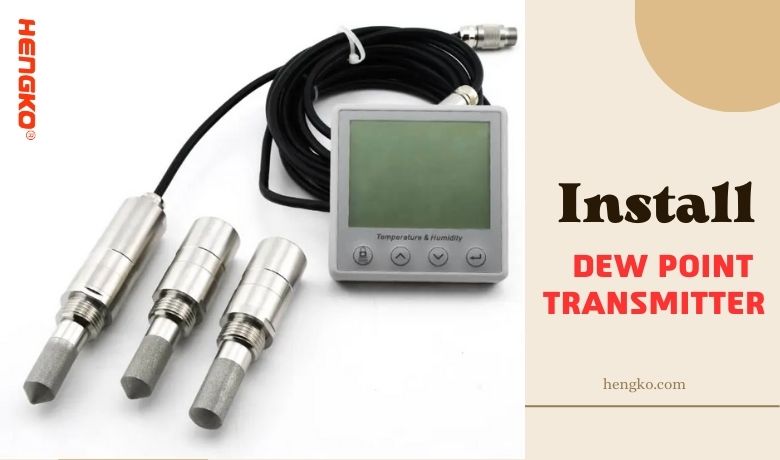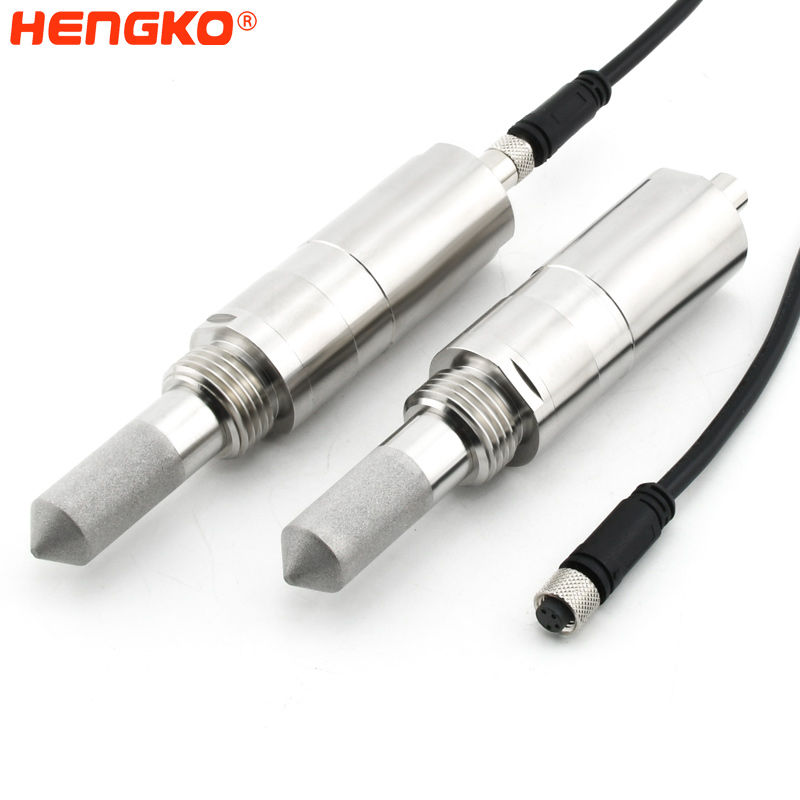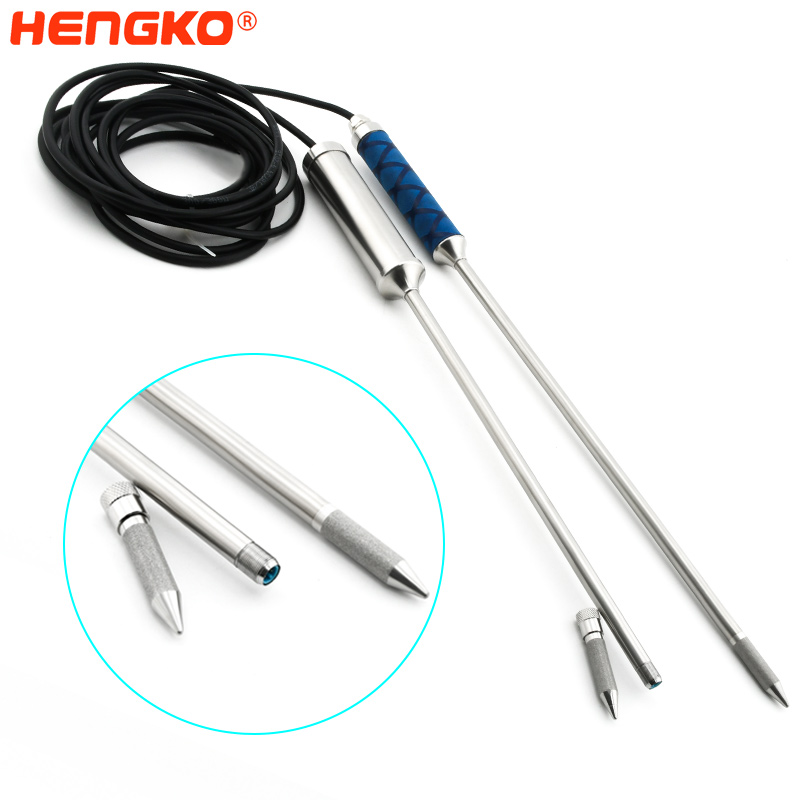How to Install a Dew Point Transmitter ?

A dew point transmitter is an essential tool when monitoring the dew point of compressed air, providing accurate measurements in real time. Dew point transmitters work by measuring the temperature at which moisture in the air begins to condense, which provides an indication of the amount of moisture in the air at any given time.
If you are looking to install a compressed air dew point transmitter, there are a few things to consider before you begin. In this article, we discuss how a dew point transmitter works, and let you know some of the most important product features, and provide a step-by-step guide on how to install a dew point transmitter in your facility.
1.) How Dew Point Transmitters Work
As mentioned earlier, dew point transmitters work by measuring the temperature at which moisture in the air begins to condense. This is done by passing a sample of compressed air through a cooled mirror. As the mirror cools, moisture from the air will eventually begin to condense on its surface. The temperature at which this happens is called the dew point temperature, which is a measure of the moisture content of the air.
Once the dew point temperature is determined, the transmitter uses this information to calculate the relative humidity of the air. This can be displayed as a value or a graph, depending on the specific capabilities of the device.
2. ) Main Features
There are several product features to consider when selecting a dew point transmitter for your facility. These include:
1. Measuring range: The measuring range of the dew point transmitter will determine the minimum and maximum detectable dew point temperature. Make sure to choose a device with a measurement range suitable for your specific needs.
2. Accuracy: The accuracy of a dew point transmitter is critical because even small deviations from the actual dew point temperature can result in inaccurate readings. Look for equipment with high precision and precision.
3. Integration: Many dew point transmitters can be integrated into existing process control systems, which is beneficial in industrial settings. Make sure to choose a device that is compatible with your existing system.
4. Durability: The dew point transmitter should be able to withstand harsh environments such as those found in industrial environments. Look for equipment that is durable and resistant to vibration, shock and moisture.
5. Maintenance: Finally, the ease of maintenance should be considered when choosing a dew point transmitter. Look for equipment that is easy to calibrate and requires minimal maintenance over its lifetime.
3.) Why You Should Use a Dew Point Transmitter
Using a dew point transmitter can offer you several advantages and benefits across various applications.
Here are some reasons why you should consider using one:
-
Humidity Measurement Accuracy: A dew point transmitter allows for precise and reliable measurement of humidity levels. It calculates the dew point temperature, which is the point at which air becomes saturated and condensation occurs. This information is crucial in processes where maintaining specific humidity levels is vital for optimal performance.
-
Preventing Condensation: By continuously monitoring the dew point, the transmitter helps prevent condensation on surfaces and equipment. Condensation can lead to corrosion, mold growth, and other damage, particularly in industrial and manufacturing settings.
-
Process Optimization: In many industrial processes, maintaining a particular dew point is critical to ensure efficiency and product quality. By using a dew point transmitter, you can control and adjust the conditions as needed, resulting in improved process optimization.
-
Energy Efficiency: In climate control systems, a dew point transmitter assists in optimizing cooling processes. By controlling the humidity levels accurately, the system can run more efficiently, leading to energy savings.
-
Environmental Monitoring: Dew point transmitters are valuable in environmental monitoring applications, such as weather forecasting and climate research. Understanding dew point conditions helps predict the likelihood of fog, frost, or rain, which can be essential for various industries like agriculture and aviation.
-
Compressed Air Systems: In compressed air systems, monitoring dew point is crucial to prevent moisture from condensing in pipes and equipment. Maintaining dry air is essential to avoid corrosion and damage to the system.
-
HVAC Systems: Dew point transmitters play a significant role in HVAC (Heating, Ventilation, and Air Conditioning) systems by helping maintain optimal humidity levels indoors. This ensures a comfortable and healthy environment for occupants while preventing issues like mold growth.
-
Data Logging and Analysis: Many dew point transmitters come equipped with data logging capabilities. This allows for the collection of historical data over time, facilitating trend analysis and enabling proactive maintenance and troubleshooting.
-
Safety and Quality Assurance: Certain industrial processes, such as pharmaceutical manufacturing or electronics production, require strict humidity control to ensure product quality and safety. Dew point transmitters help in achieving and maintaining the necessary conditions for such sensitive operations.
In summary, using a dew point transmitter provides valuable insights into humidity levels, enabling you to make informed decisions to optimize processes, improve energy efficiency, and prevent potential issues caused by moisture. Whether in industrial settings, environmental monitoring, or HVAC applications, a dew point transmitter is a valuable tool for ensuring precise humidity control and maintaining overall system integrity.
4.) How to Install a Dew Point Transmitter
Once you've selected a dew point transmitter that meets your needs, it's time to install it in your facility. Here is a step-by-step guide on how to install a compressed air dew point transmitter:
Step 1: Choose a suitable location. Choose a location for the dew point transmitter that is representative of the entire compressed air system. This could be located near the compressor, after the dryer, or where the air is consumed.
Step 2: Prepare the mounting surface. Thoroughly clean the mounting surface and make sure it is level.
Step 3: Install the dew point transmitter. Securely mount the transmitter to the mounting surface using screws or other suitable hardware.
Step 4: Connect the sampling line. Connect the sample line to the dew point transmitter and to the point in the compressed air system where the dew point is to be monitored.
Step 5: Start the transmitter. Connect the power supply to the dew point transmitter and turn it on.
Step 6: Calibrate the device. Calibrate the device according to the manufacturer's instructions and make sure it gives accurate readings.
Step 7: Monitor dew point. After installation, regularly monitor dew point measurements to ensure compressed air quality is maintained.
5.) What Data You Should Care After Dew Point Transmitter Installed?
After installing a dew point transmitter, several key data points should be monitored and analyzed to ensure effective humidity
control and to identify any potential issues. Here are some essential data you should care about:
-
Dew Point Temperature: The primary data provided by the dew point transmitter is the actual dew point temperature. This value represents the temperature at which the air becomes saturated and moisture starts to condense. Monitoring the dew point temperature helps in understanding the moisture content in the air.
-
Humidity Levels: Along with the dew point temperature, the transmitter typically measures the relative humidity (RH) of the air. This data is essential for evaluating how close the current humidity levels are to the saturation point.
-
Trends and Patterns: It's crucial to monitor trends and patterns in dew point and humidity levels over time. Analyzing historical data can reveal fluctuations and help identify seasonal or long-term changes in humidity, which may impact your processes or environment.
-
Threshold Alerts: Set up threshold alerts based on specific dew point or humidity values. When the readings cross these predefined thresholds, the system should trigger alarms or notifications. This allows for timely action to be taken if conditions deviate from the desired range.
-
Equipment Status: Dew point transmitters are often used in conjunction with other systems or equipment, such as climate control systems or compressors. Monitor the status of these systems to ensure they are functioning correctly and maintaining the desired humidity levels.
-
Data Logging: Many dew point transmitters have data logging capabilities. Regularly review the logged data to track performance, spot anomalies, and identify potential issues.
-
Correlation with Other Metrics: Depending on your specific application, it may be essential to correlate dew point and humidity data with other metrics. For instance, in industrial processes, you might want to check how variations in humidity affect production output or product quality.
-
Environmental Conditions: Consider the broader environmental conditions and how they may impact dew point and humidity levels. Factors such as ambient temperature, weather patterns, and airflow can influence moisture content in the air.
-
Calibration and Maintenance Records: Ensure that the dew point transmitter is calibrated regularly and that maintenance records are kept up-to-date. Proper calibration is vital for accurate and reliable readings.
-
Energy Consumption: If the dew point transmitter is part of an energy management system, monitor how changes in humidity levels affect energy consumption. Optimizing humidity control can lead to energy savings in certain applications.
By caring for these data points and regularly analyzing the information provided by the dew point transmitter, you can ensure efficient humidity control, prevent issues related to moisture, and optimize processes in various applications, ranging from industrial settings to HVAC systems and environmental monitoring.
Hope Those Advice can be helpful for your know more about Dew Point Transmitter .
In Conclusion
Installing a dew point transmitter is a critical step in maintaining high quality compressed air in your facility. By selecting equipment with the correct features and following the installation steps outlined in this article, you can ensure your compressed air system is operating at peak efficiency. Remember to calibrate equipment regularly, and monitor dew point measurements to ensure compressed air quality is maintained.
The dew point is the temperature the air needs to be cooled to (at constant pressure) in order to achieve a relative humidity (RH) of 100%. At this point the air cannot hold more water in the gas form.The higher the dew point rises, the greater the amount of moisture in the air.
There are two methods of measuring trace moisture in a sample gas with a dew-point transmitter:
In-situ measurements are made by placing the transmitter inside the environment to be measured.
Extractive measurements are made by installing the sensor into a block within a sample handling system and flowing the sample outside of the environment to be measured through this system.
So, We suggested that the measurement method of extraction should be adopted in the pipeline measurement, and attention should be paid to: the transmitter should be installed directly in the pipeline, and the installation point should not be too close to the bottom of the pipe body bend, because there may be some lubricating oil or other condensate liquid gathered here, which will cause pollution or damage to the sensor.
HENGKO’ dew point sensors are designed for ease of use, incorporating all the features needed to make installation and operation as simple as possible. Our solutions cover all dew point monitoring applications for industrial gases and compressed air dryers (refrigerant and desiccant).
In a word, it is necessary to pay attention to the installation position when measuring dew point. Only when the sensor is installed in an appropriate position according to the measurement requirements, can it achieve a good working state.
Want to learn more about dew point transmitters?
Contact us today at ka@hengko.com with all the details you need. We can't wait to hear from you!


